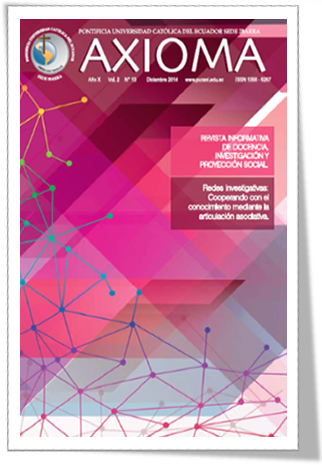Temporal Variation of Peak Hours and Hourly Volume Factors for Two Lane Highways: Case Study Loja- Zamora Highway
Main Article Content
Abstract
One of the main objectives of traffic studies is to determine the existing vehicular traffic on a particular stretch of highway under study. Key figures such as the volume and speed are usually worked with, and from these other important variables such as: peak hour factors also known by its acronym PHF are derived. This study analyzes the temporal variation of PHF for a two lane highway in a rural area and the relationship with the hourly volumes for seven continuous days of 24 hours. Data was collected by using a pneumatic counter, the MetroCount model MC5600 plus, installed in the Loja-Zamora road, in southern Ecuador. The methodology proposed by HCM-2000 was used to gather the data. The data revealed that peak hours and the relationship with the vehicular volume are similar and consistent with those obtained in studies conducted in other countries.
Downloads
Article Details
Con la finalidad de contar con un tipo de licencia más abierta en el espectro que ofrece Creative Commons, a partir de diciembre de 2022 desde el número 27, AXIOMA asume la Licencia Creative Commons 4.0 de Reconocimiento-NoComercial-CompartirIgual 4.0(CC BY-NC-SA 4.0). Tanto el sitio web como los artículos en sus diferentes formatos, reflejan esta información.
![]()
Hasta el mes de noviembre de 2022 con el número 26, la revista AXIOMA asumió una Licencia Creative Commons Atribución-NoComercial-SinDerivadas 4.0 Internacional (CC BY-NC-ND 4.0). Los artículos contenidos en cada número hasta el 26, cuentan con esta licencia y su descripción se conserva en el portal de nuestra revista.
Atribución-NoComercial-SinDerivadas
CC BY-NC-ND
AXIOMA- Revista Científica de Investigación, Docencia y Proyección Social
References
Di Leo, G., Pietrosanto, A., Sommella, P. (2009). Metrological performance of traffic detection systems. Instrumentation and Measurement, 58(9), 3199-3206.
Durbin, C. T. (2006). Traffic performance on two-lane, two-way highways: examination of new analytical approaches (Tesis de Doctorado), Montana State University.Bozeman.
Fox, K., Clark, S. (1998). Evaluating the benefits of a responsive UTC system using microsimulation. Manuscrito no publicado, University of Leeds, Leeds, United Kingdom.
Garber, N. J., Hoel, L.A. (2002). Traffic and Highway Engineering (3a Ed.). Toronto: CENGAGE Learning.
Jasrotia, R. (2011). Effect on Speed Distribution due to Intrusive and Non-Intrusive Portable Speed Measurement Devices. (Tesis de Maestría), University of Kansas. Kansas.
Karjala, S. R. (2008). Estimating quality of traffic flow on two-lane highways (Tesis de Doctorado), Montana State University. Bozeman.
Kraemer, C., Pardillo J., Rocci, S., Romana, M., Sánchez, V., del Val, M. (2004). (Vol. 1). Ingeniería de carreteras, (1a Ed). Madrid: McGraw Hill.
Marwah, B., Singh, B. (2003). Level of Service Classification for Urban Heterogeneous Traffic: A Case Study of Kanpur Metropolis. Transportation Research Board, E-CO18, 271-286.
MetroCount. (2007). ARX MTE User Manual – Classification Schemes, Georgia, MetroCount Inc.
McGowen, P., Sanderson, M. (2011, July). Accuracy of Pneumatic Road Tube Counters. Western District Annual Meeting en Institute of Transportation Engineers, Anchorage.
Ouren, D., Coffin, A. (2013). Monitoring intensity and patterns of off-highway vehicle (OHV) use in remote areas of the western USA. Oecologia Australis, 17(1), 96-110.
Polus, A., Kikuchi, S. (1989). Sampling and evaluation of peak hour factor characteristics. Recuperado de http://trid.trb.org/view.aspx?id=344402
Seetharaman, P., Errampalli, M., Senathipati, V., Shukla, A., Gangopadhyay, S. (2011). Modeling time mean speed and space mean speed for heterogeneous traffic conditions. Transportation Planning and Technology, 34(8), 823-838. doi: 10.1080/03081060.2011.613593.
Secretaría Nacional de Planificación y Desarrollo (2013). Plan Nacional para el Buen Vivir 2013-2017. Recuperado de http:// www.buenvivir.gob.ec/69.
Transportation Planning and Technology, 34(8). Recuperado de http://dx.doi.org/10.108 0/03081060.2011.613593
Wiegand, K. (2013). Traffic Monitoring Program. Recuperado de http://www.dot.ga.gov/informationcenter/statistics/TrafficData/Documents/2013_Georgia_Traffic_Monitoring_Program_4a.pdf
Xiang, W., Otto, C. W., Wen, P. (2008, December). Automated vehicle classification system using advanced noise reduction technology. Publicación presentada en 1st International Conference on Signal Processing and Communication Systems, Gold Coast, Australia. Recuperado de http://eprints.usq.edu.au/id/eprint/3707

